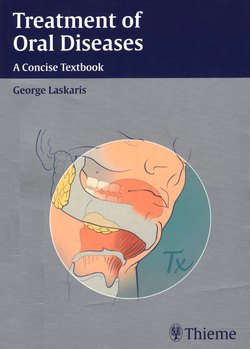Читать книгу Treatment of Oral Diseases - George Laskaris - Страница 11
ОглавлениеActinic Cheilitis
Definition
Actinic cheilitis is a relatively common precancerous disorder typically confined to the vermilion zone of the lower lip.
Etiology
Fair-skinned individuals with high occupational or recreational sun exposure are more commonly affected.
Main Clinical Features
•Chronic mild edema and erythema followed by dryness and fine scaling
•The epithelium becomes progressively thin and atrophic with hyperkeratotic whitish papules or small plaques intermingled with red areas
•Later the lip becomes very dry and scaly with erosions
•Risk of development of leukoplakia and squamous cell carcinoma is increased
Diagnosis
The clinical diagnosis should be confirmed by a biopsy and histopathologic examination.
Differential Diagnosis
•Leukoplakia
•Discoid lupus erythematosus
•Lichen planus
•Scleroderma
•Contact cheilitis
•Herpes simplex
•Cheilitis due to radiation
•Squamous cell carcinoma
Treatment
Basic Guidelines
•Sun-protective measures should always be recommended.
•Patients should use lip lubricants containing sunscreens.
•Before treatment, a biopsy is necessary to determine histologic changes.
•Periodic follow-up is necessary because of the increased risk of malignant transformation.
Suggested Therapies
•Nonsurgical procedures are recommended for patients without epithelial dysplasia or invasive squamous cell carcinoma
— Topical 5-fluorouracil cream (0.5-5%) may be applied once or twice daily for 2-3 weeks. However, because of local irritation and relatively poor results this treatment is not included in the first-line therapies.
— Recently, the topical immunomodulator. imiquimod cream 5% (Aldara) has been used successfully for the treatment of actinic cheilitis. The suggested regimen is to apply two or three times weekly for 4-6 weeks. Local adverse reactions such as erythema, edema, and erosions may occur. Systemic adverse effects, e.g., fever, headache, fatigue, diarrhea, and myalgia may occur in 1-2 % of patients.
— Carbon dioxide (CO2) laser ablation has also been used for the treatment of actinic cheilitis with excellent results.
•Surgical treatment is recommended for patients with epithelial dysplasia, carcinoma in situ, or invasive squamous cell carcinoma. Vermilionectomy is the treatment of choice in such cases.
Alternative Therapies
Alternative therapies include photodynamic therapy, i.e., application of 5-aminolevulinic acid followed by exposure to a light source, and cryosurgery. Both methods are indicated for patients without premalignant or malignant foci histologically. Radiation therapy has also been used with success.
References
Dufresne RG, Curlin MU. Actinic cheilitis: A treatment review. Dermatol Surg 1997;3:15–21.
Ishida CE, Ramos-e-Silva M. Cryosurgery in oral lesions. Int J Dermatol 1998;37:283–285.
Kaugars CE, Pillion T, Svirsky JA, et al. Actinic cheilitis. A review of 152 cases. Oral Surg Oral Med Oral Pathol Oral Radiol Endod 1999;88:181–186.
Picascia DD, Robinson JK. Actinic cheilitis: A review of the etiology, differential diagnosis and treatment. J Am Acad Dermatol 1987, 17:255–264.
Smith KJ, Germain M, Yeager J, Skclton II. Topical 5% imiquimod for the therapy of actinic cheilitis. J Am Acad Dermorol 2002;47:497–501.
Vega-Memije ME, Mosqueda-Taylor A, Irigoyen-Camacho ME, et al. Actinic prurigo cheilitis: Clinicopathologic analysis and therapeutic results in 116 cases. Oral Surg Oral Med Oral Pathol Oral Radiol Endod 2002;94:83–91.
Zelickson BD, Roenigk RK. Actinic cheilitis. Treatment with the carbon dioxide laser. Cancer 1990;5:1307–1311.
